The Ngorongoro Crater and Conservation Area is a UNESCO World Heritage Site found in the Republic of Tanzania. It was established in 1959 covering vast expanses of craters, gorges, forests, lakes, rivers, streams, savanna grasslands and woodlands. The stunning combination of landscape and wildlife rivals those in neighboring Serengeti and the Maasai Mara National Reserve. The famous award winning movie “Out of Africa” was partly filmed in Ngorongoro. The Ngorongoro Conservation Area is made up of the famous Ngorongoro crater (from which it gets its name), Olduvai Gorge and the remote crater highlands.
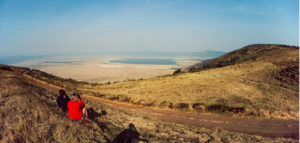 The Ngorongoro Crater is often referred to as ‘the Garden of Eden’ because it is a true paradise for animals. The crater is important for global biodiversity because it contains threatened species and high concentration of animals. It is the largest unfilled volcanic caldera in the world. The crater was formed about 3 million years ago when a large volcano (about 19,000 feet) exploded and collapsed on itself. The massive explosion left behind a floor covering an area of 260 square kilometers and 2,000 feet deep. The crater consists of water bodies like Lake Magadi and the Ngoitokitok Spring. The water bodies provide water for wildlife throughout the year but the Maasai herdsmen also use them to supply water for their animals – especially during the dry months of the year.
The Ngorongoro Crater is often referred to as ‘the Garden of Eden’ because it is a true paradise for animals. The crater is important for global biodiversity because it contains threatened species and high concentration of animals. It is the largest unfilled volcanic caldera in the world. The crater was formed about 3 million years ago when a large volcano (about 19,000 feet) exploded and collapsed on itself. The massive explosion left behind a floor covering an area of 260 square kilometers and 2,000 feet deep. The crater consists of water bodies like Lake Magadi and the Ngoitokitok Spring. The water bodies provide water for wildlife throughout the year but the Maasai herdsmen also use them to supply water for their animals – especially during the dry months of the year.
History of the Ngorongoro Conservation Area
If we are to consider the age of fossils excavated from the Olduvai Gorge, the first humans occupied the area three million years ago. After these first hominids, pastoralists like the Mbulu and Datooga ruled 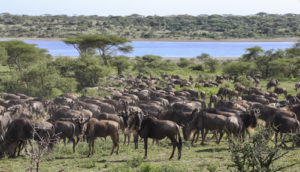 the area for over 2,000 years. The Maasai appeared in the area in the 1800’s from Sudan. When they did, they drove out the Datoog and Mbulu to remote areas of the reserve. The first European to reach the area was Oscar Baumann in 1892. When the Serengeti National Park was created in 1951, the Ngorongoro Conservation Area was part of it until it became independent in 1959. Initially the Maasai pastoralists were allowed to roam freely in the area after being relocated from the Serengeti National Park but the 2009 Ngorongoro Wildlife Conservation Act displaced them further. They were allowed to stay in the area but with greater restrictions by the Ngorongoro Conservation Area Authority. The Ngorongoro Conservation Area Authority is responsible for the overall management of the area. You might also be interested in the article about Climbing Mount Kilimanjaro.
the area for over 2,000 years. The Maasai appeared in the area in the 1800’s from Sudan. When they did, they drove out the Datoog and Mbulu to remote areas of the reserve. The first European to reach the area was Oscar Baumann in 1892. When the Serengeti National Park was created in 1951, the Ngorongoro Conservation Area was part of it until it became independent in 1959. Initially the Maasai pastoralists were allowed to roam freely in the area after being relocated from the Serengeti National Park but the 2009 Ngorongoro Wildlife Conservation Act displaced them further. They were allowed to stay in the area but with greater restrictions by the Ngorongoro Conservation Area Authority. The Ngorongoro Conservation Area Authority is responsible for the overall management of the area. You might also be interested in the article about Climbing Mount Kilimanjaro.
The Ngorongoro Crater and Olduvai Gorge
Ngorongoro Crater
The Ngorongoro crater is one of the best places to view wildlife in Africa. It is estimated that over 24,000 large mammals live in the Ngorongoro Crater. They include waterbucks, African leopards, black rhinos, buffaloes, cheetahs, crocodiles, East African wild dogs, elands, grant’s gazelle, zebra, hippopotamus, impala, lions, oribi, Thomson’s gazelles, topi and wildebeest. Most of these animals remain in the natural enclosure without migrating except for a few wildebeest and elephants. This has led to significant inbreeding in some species like lions.
Wildlife is not only prevalent in the Ngorongoro Crater. As one moves out of the crater and into the wider Ngorongoro Conservation Area there are healthy populations of wildlife too. Around the Ndutu Lake is a strong lion and cheetah population. Other animals around the lake are jackals, spotted hyena, wild dogs and servals to mention a few. The Ngorongoro Conservation Area is host to the famous great migration in East Africa. In December, about 1.6 million wildebeest, 450,000 zebras and 265,000 gazelle move through the area from the South. In June the same number moves back to the North.
Olduvai Gorge
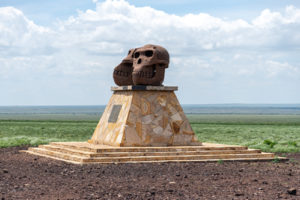 The Olduvai Gorge is found in-between the Serengeti plains and the Ngorongoro Crater. Archaeologists consider it to be the seat of humanity because remains of the very earliest known humans were first discovered there. Olduvai Gorge is visited by thousands of tourists who are interested in learning about the work of the Leakey family and understanding how the earliest humans evolved. There is a small museum at the sight where fossils dating back to about 3 million years ago are kept.
The Olduvai Gorge is found in-between the Serengeti plains and the Ngorongoro Crater. Archaeologists consider it to be the seat of humanity because remains of the very earliest known humans were first discovered there. Olduvai Gorge is visited by thousands of tourists who are interested in learning about the work of the Leakey family and understanding how the earliest humans evolved. There is a small museum at the sight where fossils dating back to about 3 million years ago are kept.
Tourism within the Ngorongoro Conservation Area
The Ngorongoro conservation area is one of the best places to view wildlife in Africa. It is also one of the most visited tourist attractions in Tanzania. The main activities in the Ngorongoro Conservation Area are walking safaris to observe wildlife from the rim of the crater (can take about 6 hours), camping along the rim of the crater, visiting the local Maasai villages and a game drive around and in the crater itself. Other attractions include Lake Magadi, Lerai Fever Tree Forest, Olduvai Gorge, the Shifting Sands, the Gol Mountains, the Olmoti Crater, the Empakaai Crater, Ol Karien Gorge, Nasera Rock, Salei Plains, Oldeani Mountain, Lake Natron, Ol Doinyo Lengai and visiting the Hadzabe Tribe.
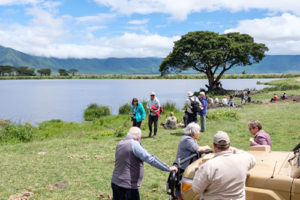 Lake Magadi is a shallow alkaline-filled lake and a favorite habitat for both lesser and greater flamingos. Flamingos and other birds love the lake because of its remoteness, salty waters and abundant algae. Other animals like hyenas and jackals visit the lake to supplement their diet by licking salt. The Lerai Fever Tree Forest consists of a rare type of yellowish and slim acacia trees. These trees are a favorite of rhinos, bushbucks, elephants, eland, hyrax and birds. The Shifting sands are a result of ash coming out from Ol Dionyo mountain. This ash moves slowly over the vast plains providing a great spectacle for tourists to happen to visiting the area. Apart from the Ngorongoro crater, the area has other large craters like the Olmoti and Empakaai. These two craters are excellent for nature walks to encounter wildlife and the Maasai herdsmen looking after their domestic animals. The remote and pristine Gol Mountains are also a key attraction within the Ngorongoro Conservation area. It lies along a major route used by thousands of zebras and wildebeest as they migrate to and from the Serengeti plains.
Lake Magadi is a shallow alkaline-filled lake and a favorite habitat for both lesser and greater flamingos. Flamingos and other birds love the lake because of its remoteness, salty waters and abundant algae. Other animals like hyenas and jackals visit the lake to supplement their diet by licking salt. The Lerai Fever Tree Forest consists of a rare type of yellowish and slim acacia trees. These trees are a favorite of rhinos, bushbucks, elephants, eland, hyrax and birds. The Shifting sands are a result of ash coming out from Ol Dionyo mountain. This ash moves slowly over the vast plains providing a great spectacle for tourists to happen to visiting the area. Apart from the Ngorongoro crater, the area has other large craters like the Olmoti and Empakaai. These two craters are excellent for nature walks to encounter wildlife and the Maasai herdsmen looking after their domestic animals. The remote and pristine Gol Mountains are also a key attraction within the Ngorongoro Conservation area. It lies along a major route used by thousands of zebras and wildebeest as they migrate to and from the Serengeti plains.
Nasera rock contain an ancient shelter discovered by the Leakey family during one of their excavations. The Ol Karien Gorge is excellent for birding and is where griffon vulture breeds between March 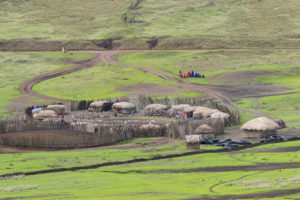 and April. To the north east and close to the border with Kenya is the Ol Doinyo Lengai Mountains. These remote mountains are still active and attract brave hikers who are interested in staring at the main lava-filled crater. For an amazing cultural tour in Tanzania, one can visit the Maasai villages or the Hadzabe Tribe living close to Lake Eyasi. These bushmen still rely on hunting and gathering to survive. Their language consists of mostly whistles and clicks. The Hadzabe live close to the Datoga and Mbulu who survive on farming and pastoralism. If you are planning to visit the Ngorongoro Crater soon, you might find our 3 days Serengeti and Ngorongoro safari package interesting. We also have an amazing 6 days gorilla tour, Ngorongoro and Serengeti safari package.
and April. To the north east and close to the border with Kenya is the Ol Doinyo Lengai Mountains. These remote mountains are still active and attract brave hikers who are interested in staring at the main lava-filled crater. For an amazing cultural tour in Tanzania, one can visit the Maasai villages or the Hadzabe Tribe living close to Lake Eyasi. These bushmen still rely on hunting and gathering to survive. Their language consists of mostly whistles and clicks. The Hadzabe live close to the Datoga and Mbulu who survive on farming and pastoralism. If you are planning to visit the Ngorongoro Crater soon, you might find our 3 days Serengeti and Ngorongoro safari package interesting. We also have an amazing 6 days gorilla tour, Ngorongoro and Serengeti safari package.
Threats to the Ngorongoro Conservation Area
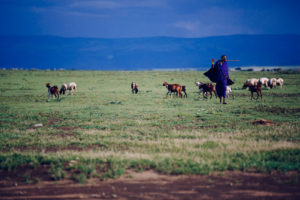 Whereas the Ngorongoro Conservation Area generally has good management structures in place, there are several threats to the Eco-system that need to be addressed. The main threats come from the increasing population of humans and domestic animals living within the area. From only 9,000 people in the area in 1966, there are now over 70,000 people living within the World Heritage site. People from other parts of the country were attracted to the area because of the booming tourism industry and better social services.
Whereas the Ngorongoro Conservation Area generally has good management structures in place, there are several threats to the Eco-system that need to be addressed. The main threats come from the increasing population of humans and domestic animals living within the area. From only 9,000 people in the area in 1966, there are now over 70,000 people living within the World Heritage site. People from other parts of the country were attracted to the area because of the booming tourism industry and better social services.
Tourism requires supporting infrastructure like lodges and roads which have become a real threat to the overall ecology of the area. As humans and livestock populations increase, there are more occurrences of wild fires and transfer of diseases usually associated with domestic animals. Increasing numbers of tourists in the area is also a threat especially when you consider the overcrowding during peak seasons. The government has attempted to limit the amount of time spent at Ngorongoro crater by charging higher fees. Other threats to the Ngorongoro Conservation Area include construction of roads, poaching, illegal logging, human-wildlife conflicts and invasive plants that didn’t exist in the area before. Finally, even though the area receives a significant number of tourists, available funding to for management remains limited
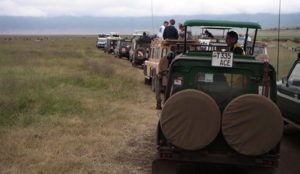 In order to address the challenges mentioned above, the Ngorongoro Conservation Authority uses some of the funds generated from tourism to strengthen the protection and management of the area. However, funds have been hard to come by especially during international lock-downs related to COVID-19. Over reliance on international travelers shouldn’t be a major issue if domestic tourism was promoted. The Ngorongoro Conservation Authority has also ensured that the money collected from tourism benefits the local communities living within and close to the area. The Ngorongoro Conservation Authority also monitors changes in the lifestyle of the Maasai to ensure that it doesn’t have a negative impact on the area. There have also been restrictions and control of livestock movement within the conservation area.
In order to address the challenges mentioned above, the Ngorongoro Conservation Authority uses some of the funds generated from tourism to strengthen the protection and management of the area. However, funds have been hard to come by especially during international lock-downs related to COVID-19. Over reliance on international travelers shouldn’t be a major issue if domestic tourism was promoted. The Ngorongoro Conservation Authority has also ensured that the money collected from tourism benefits the local communities living within and close to the area. The Ngorongoro Conservation Authority also monitors changes in the lifestyle of the Maasai to ensure that it doesn’t have a negative impact on the area. There have also been restrictions and control of livestock movement within the conservation area.
Additional Information about the Ngorongoro Crater and general Conservation Area
The Ngorongoro crater can be accessed by road and air. Most tourists arrive at Arusha International Airport using one of the major airlines and then proceed to Ngorongoro by road or smaller charter flights. If you book your safari using a tour company, they should provide a car to take you from Arusha up to Ngorongoro. Daily Charter flights are available from Arusha to Lake Manyara where your tour company or hotel should be waiting to pick you up.
When is the best time to visit the Ngorongoro Crater? The Ngorongoro Crater can be visited throughout the year because the animals remain in the crater throughout the year. Most tourist visit the area during the dry season between June and October. Though spotting game is easier because of the shorter grass, 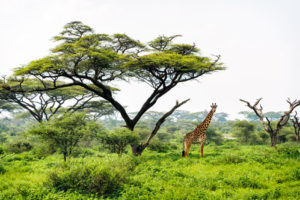 the crater can get too crowded. What happens in each season? In January to February, thousands of wildebeest calve just outside the crater and this is an excellent time to take photos or watch wildlife battles. From March to May, the area receives heavy rains which turn everything lush green but with less visitors. It is the best time for birding. Birders should expect to spot white backed vultures, weavers, splay-footed ostriches, secretary birds, rosy-breasted longclaw, long-crested eagles, lesser flamingos, harriers, grotesque kori bustards, grey crowned cranes, caspian lapwing, blue mantled superb starlings and Augur buzzards.
the crater can get too crowded. What happens in each season? In January to February, thousands of wildebeest calve just outside the crater and this is an excellent time to take photos or watch wildlife battles. From March to May, the area receives heavy rains which turn everything lush green but with less visitors. It is the best time for birding. Birders should expect to spot white backed vultures, weavers, splay-footed ostriches, secretary birds, rosy-breasted longclaw, long-crested eagles, lesser flamingos, harriers, grotesque kori bustards, grey crowned cranes, caspian lapwing, blue mantled superb starlings and Augur buzzards.
Where will I stay in Ngorongoro? There are several accommodation facilities built around the Ngorongoro crater. Most are built on the Rift Valley Escarpment or on the Crater rim. They come in 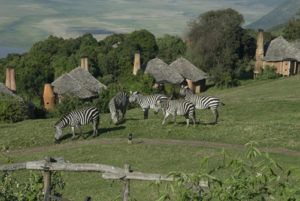 form of standard lodges, eco-lodges, bush camps, country cottages, mobile camps and tented camps. The final choice of accommodation depends on your budget, kind of experience and level of comfort you want. It doesn’t matter if you are a luxury traveler with a desire for the ultimate comfort or a backpacker only interested in the basics. Everyone finds somewhere decent to stay in while visiting the area. An example of a great luxury lodge is the Ngorongoro Crater Lodge while a good budget lodge would be Ngorongoro Rhino Lodge. There is also the Ngorongoro Farm House and Plantation Lodge near Karatu. If you are interested in tented bush camps, you can check out Lemala Ngorongoro, the seasonal Kirurumu Ngorongoro Camp and Rhotia Valley Tented Lodge.
form of standard lodges, eco-lodges, bush camps, country cottages, mobile camps and tented camps. The final choice of accommodation depends on your budget, kind of experience and level of comfort you want. It doesn’t matter if you are a luxury traveler with a desire for the ultimate comfort or a backpacker only interested in the basics. Everyone finds somewhere decent to stay in while visiting the area. An example of a great luxury lodge is the Ngorongoro Crater Lodge while a good budget lodge would be Ngorongoro Rhino Lodge. There is also the Ngorongoro Farm House and Plantation Lodge near Karatu. If you are interested in tented bush camps, you can check out Lemala Ngorongoro, the seasonal Kirurumu Ngorongoro Camp and Rhotia Valley Tented Lodge.

